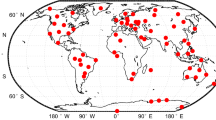Abstract
In this study, the correlation between T m, a key variable in GNSS water vapor inversion, and surface temperature (T s) was calculated on a global scale based on the global geodetic observing system (GGOS) atmosphere T m data and European centre for medium-range weather forecasts (ECMWF) surface temperature data. The results show that their correlation is mainly affected by latitudes, and the correlation is stronger at high latitudes and weaker at low latitudes. Although the correlation is relatively weak in the tropic areas, the temperature changes so little in a year in these areas that we can still achieve good T m results by linear regression model. Based on these facts, “GGOS atmosphere” T m data and ECMWF T s data from 2005 to 2011 were used to establish the global latitude-related linear regression model. The new model has root mean square error (RMSE) of 3.2, 3.3, and 4.4 K, respectively, compared with respect to the “GGOS atmosphere” data, COSMIC data, and radiosonde data and is more accurate than the Bevis T m–T s relationship.










Similar content being viewed by others
References
Rocken C, Van Hove T, Ware RH (1997) Near real-time GPS sensing of atmospheric water vapor. Geophys Res Lett 24:3221–3224
Rocken C, Anthes R, Exner M (1997) Analysis and validation of GPS/MET data in the neutral atmosphere. J Geophys Res 102:29849–29866
Li CG, Mao JT, Li JG et al (1999) Remote sensing precipitable water with GPS. Chin Sci Bull 44:1041–1044
Davis JL, Herring TA, Shapiro II et al (1985) Geodesy by radio interferometry: effects of atmospheric modeling errors on estimates of baseline length. Radio Sci 20:1593–1607
Bevis M, Businger S, Chiswell S et al (1994) GPS meteorology: mapping zenith wet delays onto precipitable water. J Appl Meteorol 33:379–386
Bevis M, Businger S, Herring TA et al (1992) GPS meteorology: remote sensing of atmospheric water vapor using the global positioning system. J Geophys Res 97:15787–15801
Ross RJ, Rosenfeld S (1997) Estimating mean weighted temperature of the atmosphere for global positioning system applications. J Geophys Res 102:21719–21730
Ross RJ, Rosenfeld S (1999) Correction to “estimating mean weighted temperature of the atmosphere for global positioning system application”. J Geophys Res 104:27625
Chen JY (1998) On the error analysis for the remote sensing of atmospheric water vapor by ground based GPS. Acta Geod Cartrogr Sin 27:114–118
Li JG, Mao JT, Li CC (1999) The approach to remote sensing of water vapor based on GPS and linear regression T m in eastern region of China. Acta Meteorol Sin 57:284–291
Liou YA, Teng YT, Van Hove T et al (2001) Comparison of precipitable water observations in the near tropics by GPS, microwave radiometer, and radiosondes. J Appl Meteorol 40:5–15
Baltink HK, van der Marel H, van der Hoeven AGA (2002) Integrated atmospheric water vapor estimates from a regional GPS network. J Geophys Res 107:4025
Bokoye AI, Royer A, O’Neill NT et al (2003) Multisensor analysis of integrated atmospheric water vapor over Canada and Alaska. J Geophys Res 108:4480
Wang Y, Liu LT, Xu HZ et al (2007) Retrieving change of precipitable water vapor in Chinese Mainland by GPS technique. Geom Inf Sci Wuhan Univ 32:152–154
Jade S, Vijayan MSM (2008) GPS-based atmospheric precipitable water vapor estimation using meteorological parameters interpolated from NCEP global reanalysis data. J Geophys Res 113:1–12
Yao YB, Zhu S, Yue SQ (2012) A globally applicable, season-specific model for estimating the weighted mean temperature of the atmosphere. J Geod 86:1125–1135
Acknowledgements
Thank the ECMWF for providing surface temperature data and “GGOS atmosphere” for providing global T m data.
Author information
Authors and Affiliations
Corresponding author
About this article
Cite this article
Yao, Y., Zhang, B., Xu, C. et al. Analysis of the global T m–T s correlation and establishment of the latitude-related linear model. Chin. Sci. Bull. 59, 2340–2347 (2014). https://doi.org/10.1007/s11434-014-0275-9
Received:
Accepted:
Published:
Issue Date:
DOI: https://doi.org/10.1007/s11434-014-0275-9




